We will be undertaking a 12-day field project off Hawai‘i Island starting July 17, 2014. We have several primary goals for this project – perhaps the most ambitious is to try to deploy LIMPET satellite tags on dwarf sperm whales – something that has never been done before. This species has a reputation for being difficult to approach, but over the years we’ve encountered this species on more than 75 occasions in Hawai‘i and have learned to predict their behavior to some degree. We’ve obtained funding from the Office of Naval Research Marine Mammals and Biology Program to try to obtain movement and diving behavior data from this poorly-known species using LIMPET satellite tags. We also have funding from the Pacific Islands Fisheries Science Center to continue our work with false killer whales and pantropical spotted dolphins. We also have funding from Dolphin Quest for a small number of LIMPET satellite tags that we hope to deploy on other species (beaked whales, sperm whales, pygmy killer whales, melon-headed whales, bottlenose dolphins, or rough-toothed dolphins), to help understand their movements and habitat use. As always we will also be using photo-identification and biopsy sampling of most species to learn more about the abundance and population structure of Hawaiian odontocetes.
The research crew for this project will include Daniel Webster, Brenda Rone, Kelly Beach and Robin Baird, all from Cascadia, Jim Ward, and a number of volunteers.
If you want some background information on our work in Hawai‘i we published a paper on our first 13 years of surveys and a pdf is available here
End of project update
On our last day on the water we encountered a group of four Risso’s dolphins, our 11th species of odontocete for the trip and only our 9th sighting ever of this species in Hawaiian waters. Our last Risso’s sighting was in August 2012. All eight of our previous sightings of Risso’s have been off the island of Hawai‘i – we’ve not encountered them off any of the other islands, primarily because this species appears to primarily use very deep waters (7 of the previous 8 sightings were in >3,500 m depth, and this sighting was in 3,700 m of water).
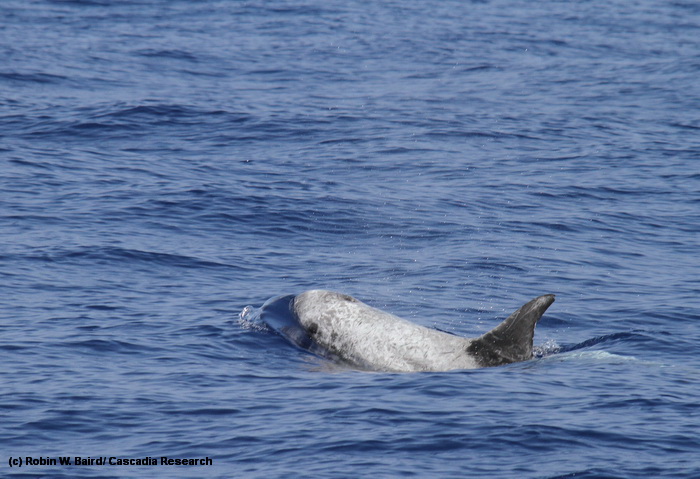
A Risso’s dolphin off Kona, July 28, 2014. Photo (c) Robin W. Baird
Over the 12-day project we had 40 encounters with 11 species of odontocetes, took 26,000+ photographs, collected three squid, deployed two satellite tags on melon-headed whales and collected three biopsy samples. Overall a very successful effort.
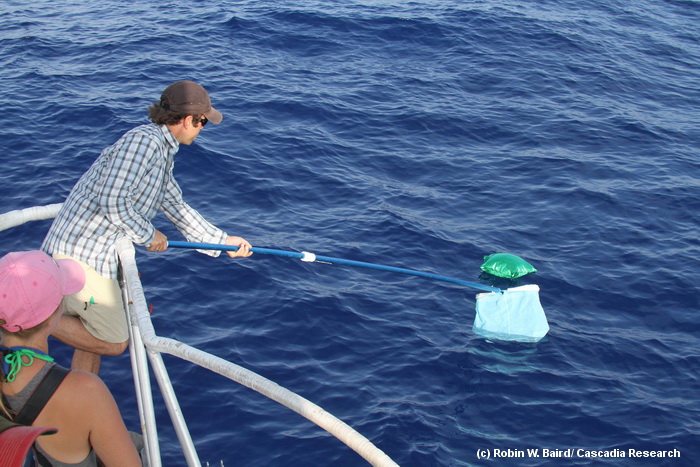
Picking up a balloon off Kona, July 28, 2014. Photo (c) Robin W. Baird
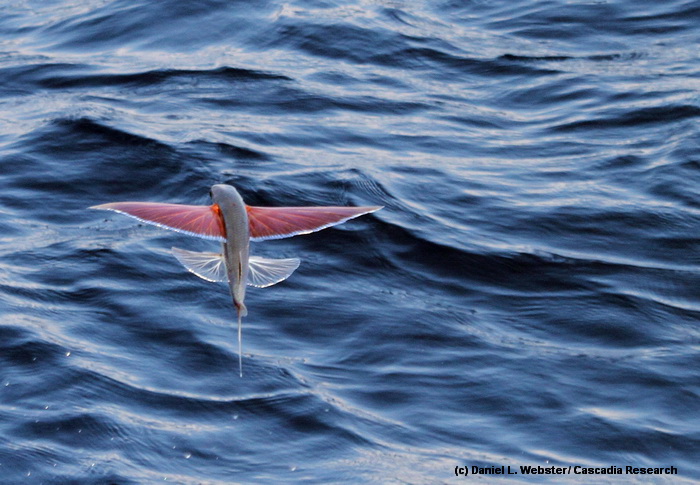
A large flying fish off Kona, July 27, 2014. Photo (c) Daniel L. Webster
July 25th update
Today we encountered our 10th species of odontocete for the trip, a pair of Blainville’s beaked whales. These individuals are part of the Hawai‘i Island resident population – we recognized the female to be HIMd007 in our catalog, first documented off the island in 1997, and the first beaked whale we encountered here when we started working off Kona in 2002.
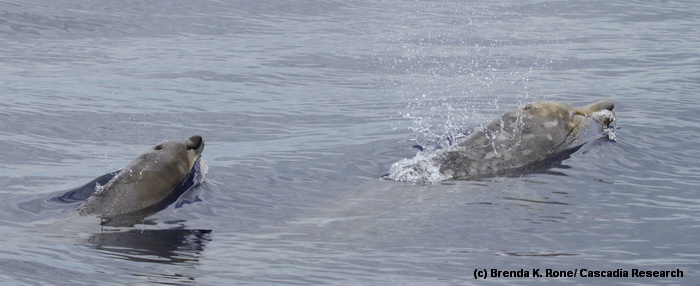
Mother and calf Blainville’s beaked whale, July 25, 2014. Photo (c) Brenda K. Rone. For more information on beaked whales in Hawaiian waters click here
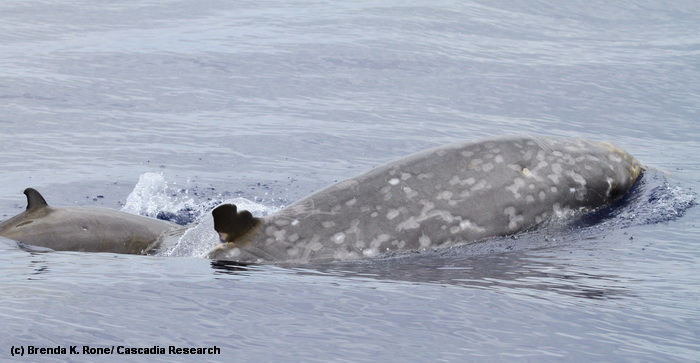
The adult female Blainville’s is covered in white scars from cookie-cutter shark bites, and is easily recognizable due to the distinctive dorsal fin. Photo (c) Brenda K. Rone
July 23rd update
Today we saw our 9th species for the trip, a group of about 220 melon-headed whales. There are two populations of melon-headed whales in Hawaiian waters, a resident population that uses the shallow waters of the Kohala area of Hawaii Island, and a main Hawaiian Islands population that uses deeper waters, moving among the islands and offshore. The group we encountered today was in about 3,000 m of water, so is likely from the main Hawaiian Islands population. We obtained several thousand identification photographs, satellite tagged two individuals, and collected three biopsy samples, so will be able to confirm which population we were with in multiple ways.
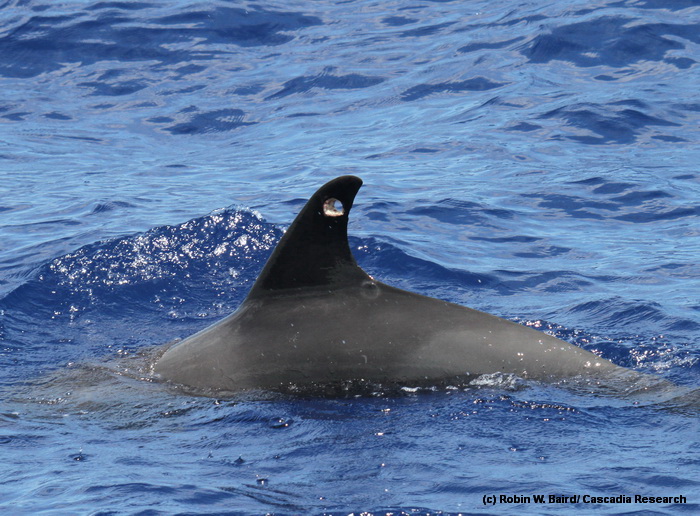
A melon-headed whale with a hole through the fin, likely caused by a cookie-cutter shark bite, July 23, 2014. Photo (c) Robin W. Baird
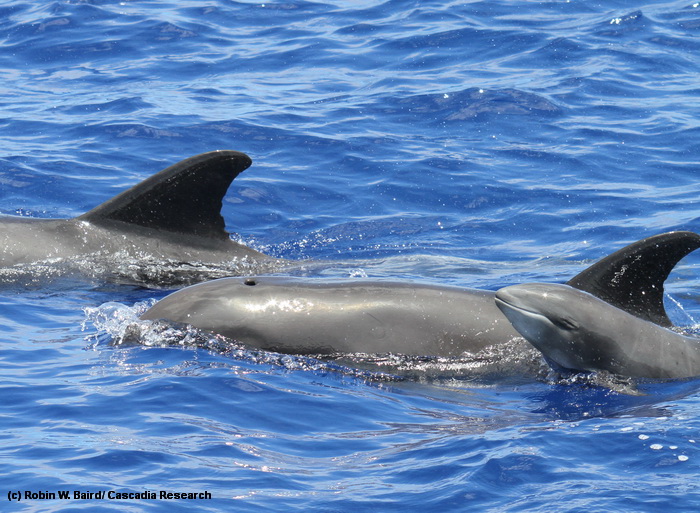
Two distinctive melon-headed whales and a newborn calf, July 23, 2014. The calf has faint “fetal folds” visible, suggesting it is less than a couple of months old. Photo (c) Robin W. Baird
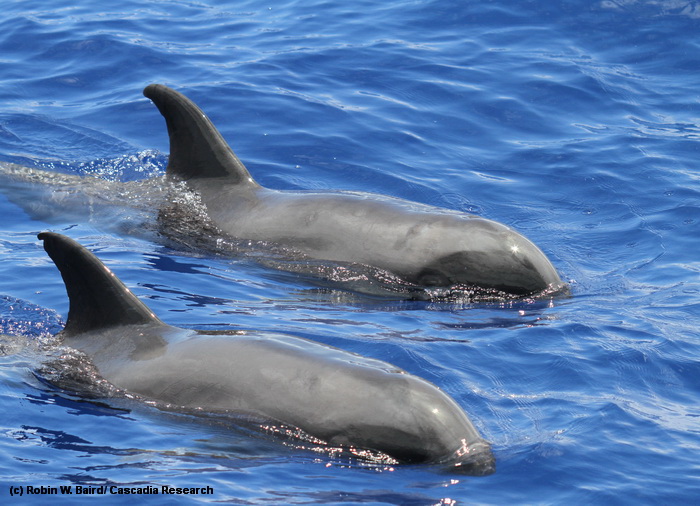
Two distinctive melon-headed whales, showing the characteristic facial “mask” as well as the diffuse grey boundary between the cape and the lateral pigmentation. Photo (c) Robin W. Baird
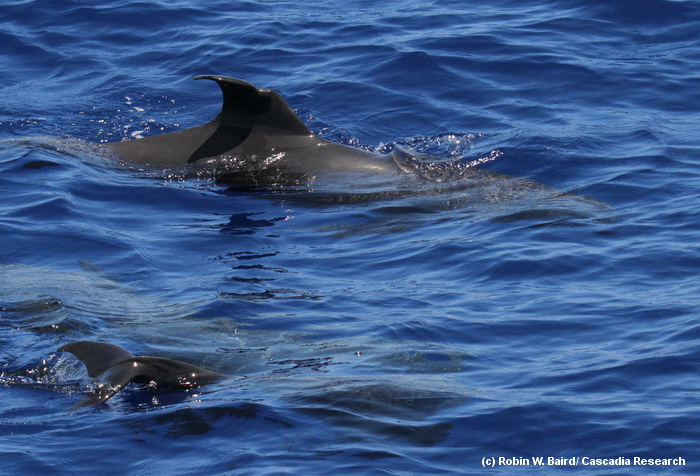
A melon-headed whale with a linear cut through the leading edge of the dorsal fin, causing the fin to partially collapse to the right. Photo (c) Robin W. Baird
July 21st update
Today we encountered a group of short-finned pilot whales, the most frequently encountered odontocete in our study. Along with photo-identifying individuals, we are collecting acoustic recordings for a study being undertaken by Amy Van Cise, a Ph.D. student at Scripps Institution of Oceanography. We also encountered several groups of spotted dolphins and collected our second squid for the project.
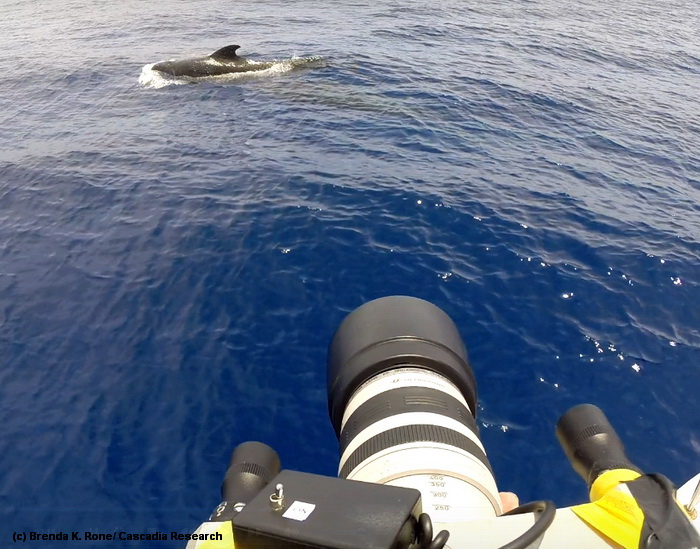
Using a laser photogrammmetry system to take measurements of a short-finned pilot whale. Photo (c) Brenda K. Rone. This system uses two green dot lasers, spaced exactly 15 cm apart, that project the green dots onto the dorsal fins of pilot whales and other species. We can then use the dots, a known distance apart, to measure the dorsal fin as well as other body measurements, for example the blowhole to dorsal fin. These measurements help us assess age class for a number of species.
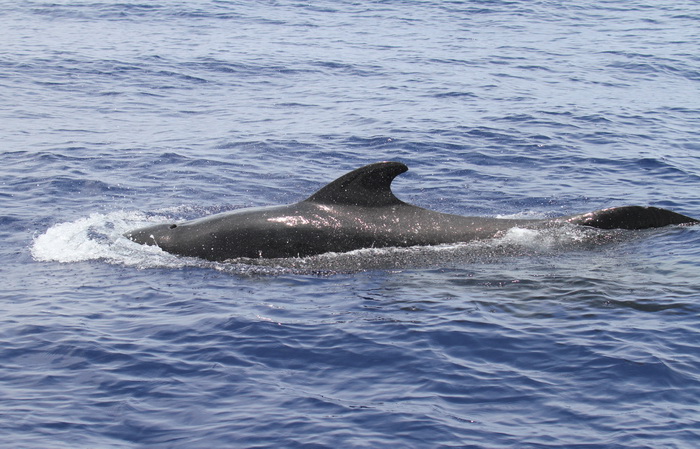
Short-finned pilot whale, July 21, 2014. Photo (c) Kelly Beach
July 20th update
In the last two days we’ve added several new species for the trip, bringing the total number of odontocete species seen in the first four days to seven.
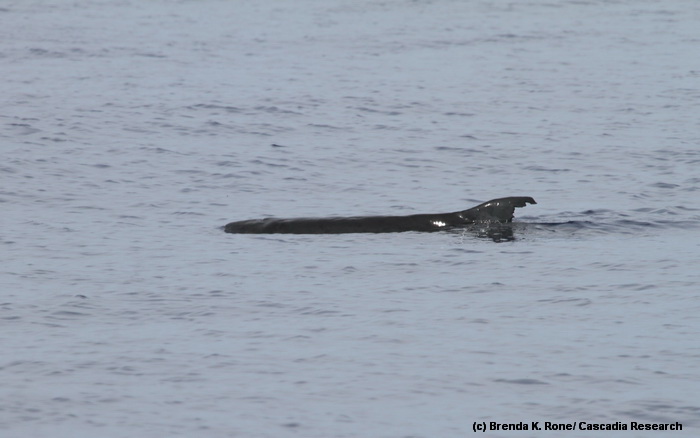
A very distinctive adult dwarf sperm whale, July 20, 2014. Photo (c) Brenda K. Rone. We did encounter a pair of one of our high priority species, dwarf sperm whales – we were able to photo-identify both individuals, and track them over several dive cycles, but lost the pair when the weather conditions deteriorated to a Beaufort 2.
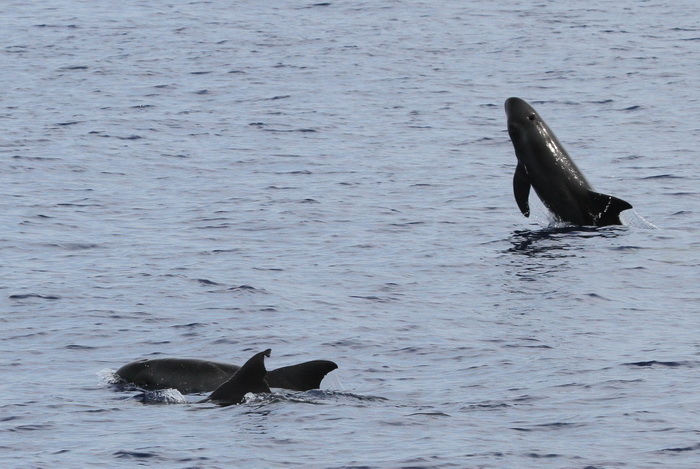
Pygmy killer whales, July 20, 2014. Photo (c) Cheryl King. We encountered our second group of pygmy killer whales, a different group than encountered on our first day. Like the first day, we recognized many of the individuals in the field and will be comparing them to our catalog to determine who was present.
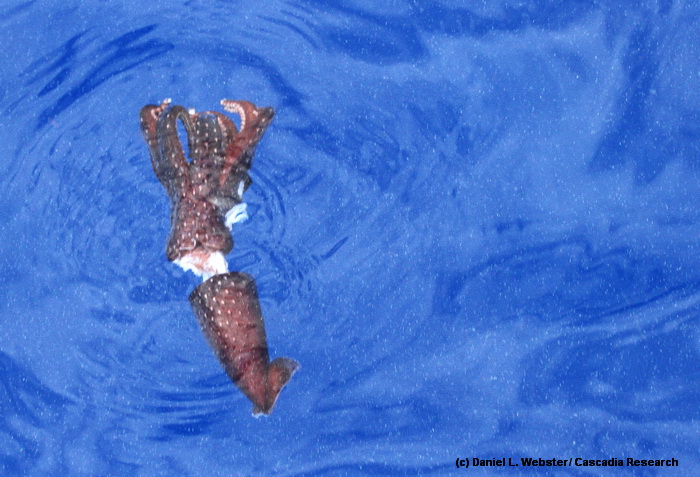
Our first squid collected for the trip, July 19, 2014. Photo (c) Daniel L. Webster. We collect floating dead squid whenever the opportunities allow, to get a better idea of what squid species are available for different species of whales and dolphins to eat, and to generally learn more about squid in Hawaiian waters. Some of the results of this work were presented as a poster at the 2013 Pacific Seabird Group conference – you can download a copy here
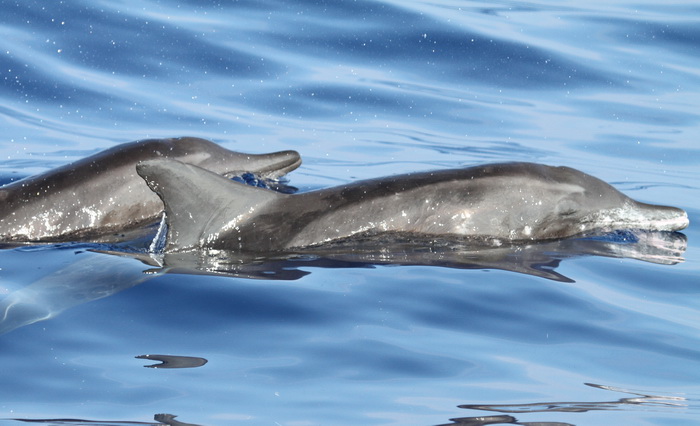
Rough-toothed dolphins, July 19, 2014. Photo (c) Brenda K. Rone. We encountered a group of four rough-toothed dolphins, and were able to obtain identification photos of three of the four individuals. Like the other species encountered this trip, rough-toothed dolphins are resident to the island and we are hoping to be able to find matches to our photo-identification catalog.
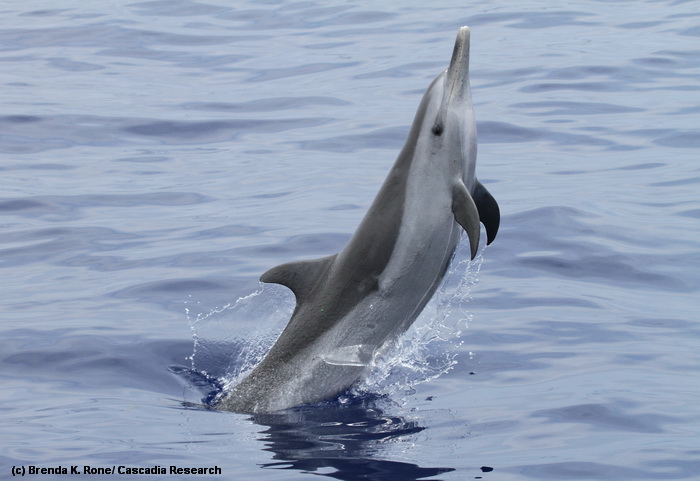
A leaping pantropical spotted dolphin, July 19, 2014. Photo (c) Brenda K. Rone.
July 18th update
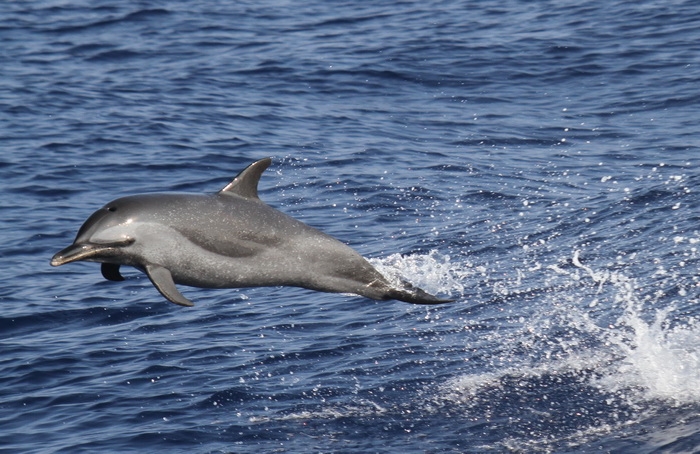
A pantropical spotted dolphin wake-riding, July 18, 2014. Photo (c) Cheryl King. Today we encountered two groups of spotted dolphins and a group of short-finned pilot whales. These two species are the most frequently encountered species of toothed whales in Hawaiian waters, representing almost 50% of all our sightings over the years. Spotted dolphins are probably the most abundant species of odontocete around the main Hawaiian Islands.
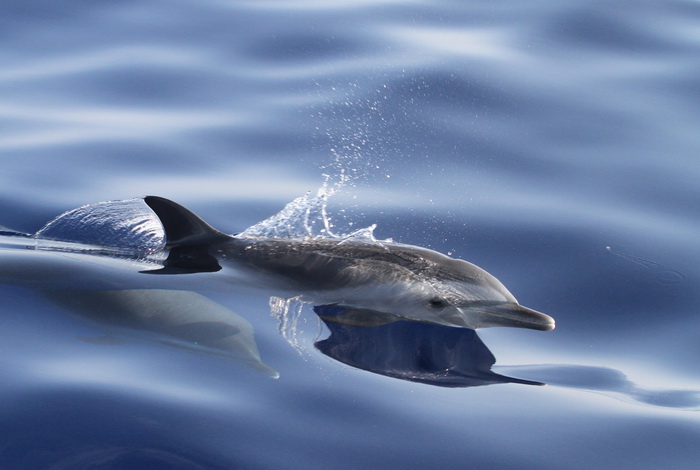
Pantropical spotted dolphin, Photo (c) Jim Ward.
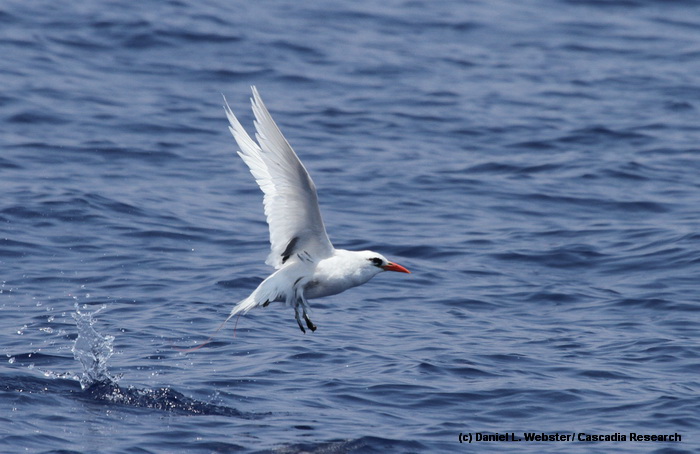
Red-tailed Tropicbird off Kona, July 18, 2014. Photo (c) Daniel L. Webster. We also record bird sightings and photograph less common species – for more information on birds in Hawai‘i see our sea bird page.
July 17th update
Today we encountered one of the less common species of resident toothed whales off the island, a group of ~22 pygmy killer whales. Pygmy killer whales are one of the rarest species of dolphins in the world, and Hawai‘i is home to the only known resident population of this species. More is known about this species from Hawaiian waters than from anywhere else in the world. We were able to obtain identification photos of most of the individuals in the group, and have already matched some to our photo-identification catalog.
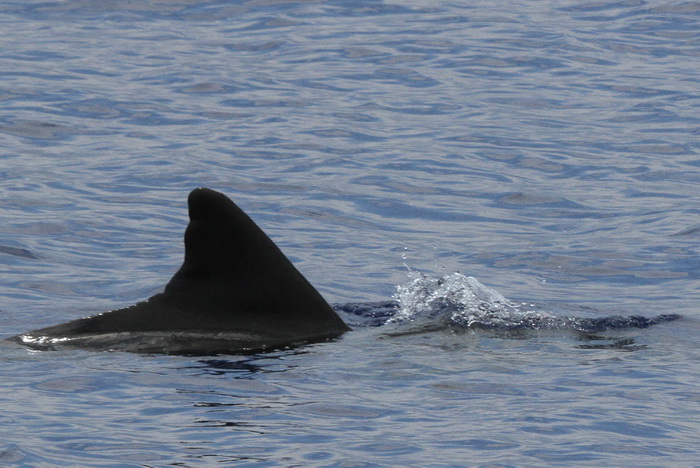
This individual, HIFa166 in our catalog, was first documented off the island in 1993 by Dan McSweeney of the Wild Whale Research Foundation. Photo (c) Suzanne Canja.
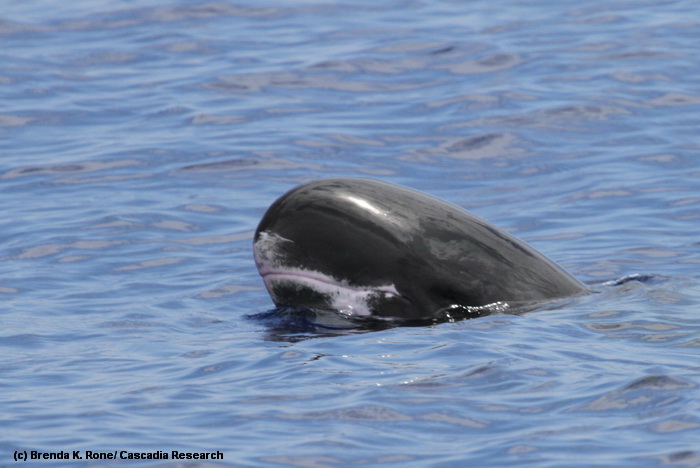
A pygmy killer whale spyhopping – older individuals of this species typically have a lot of white pigmentation on the face – this individual also has white scarring associated with injuries on the mouthline. Photo (c) Brenda K. Rone
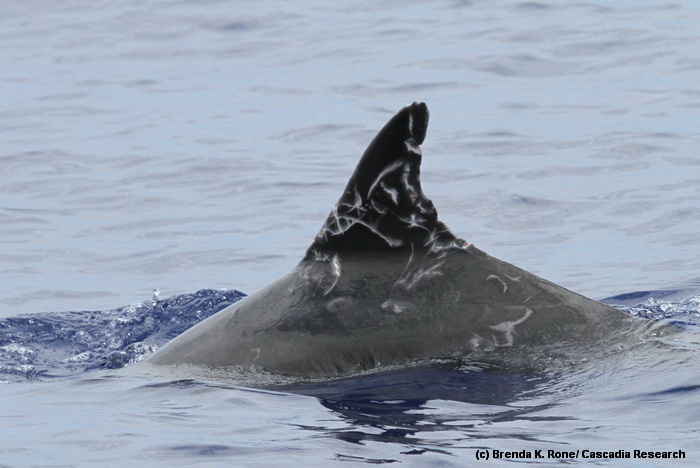
A pygmy killer whale that appears to have survived a shark attack. Photo (c) Brenda K. Rone.
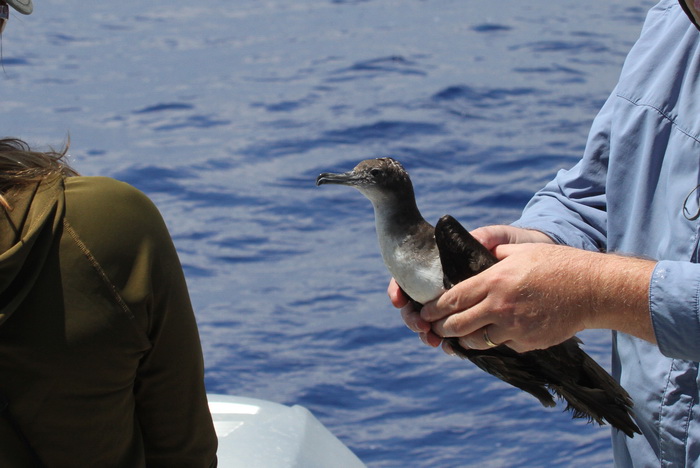
Today we also picked up an injured Wedge-tailed Shearwater – this bird was unable to fly and was probably not going to survive for long – the shearwater was delivered to the Hawai‘i Wildlife Center, who will try to rehabilitate and release the bird. Photo (c) Jim W. Ward
Some photos from previous projects below.
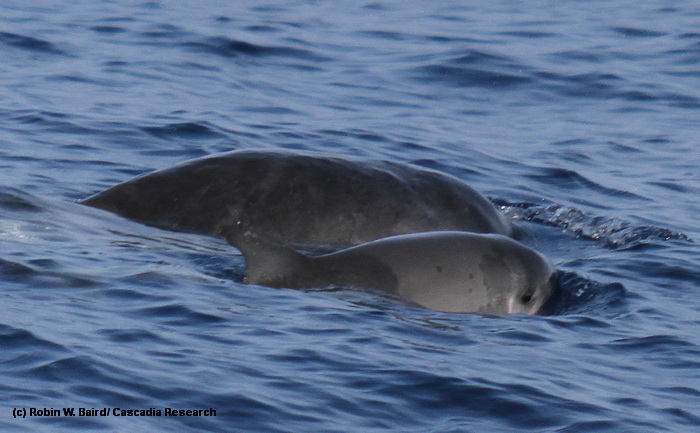
Mother and calf pair of dwarf sperm whales off Kona, October 25, 2011. Photo (c) Robin Baird
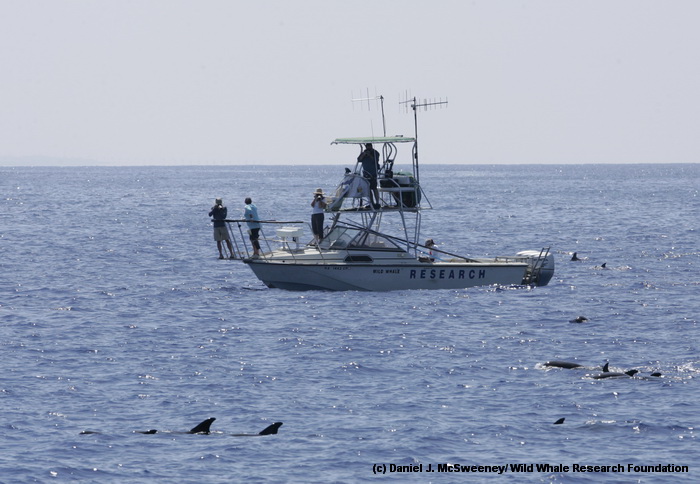
The R/V Wild Whale, a 27′ Boston Whaler, our primary research vessel, with a group of melon-headed whales off Kona, October 19, 2011. Photo (c) Dan McSweeney.
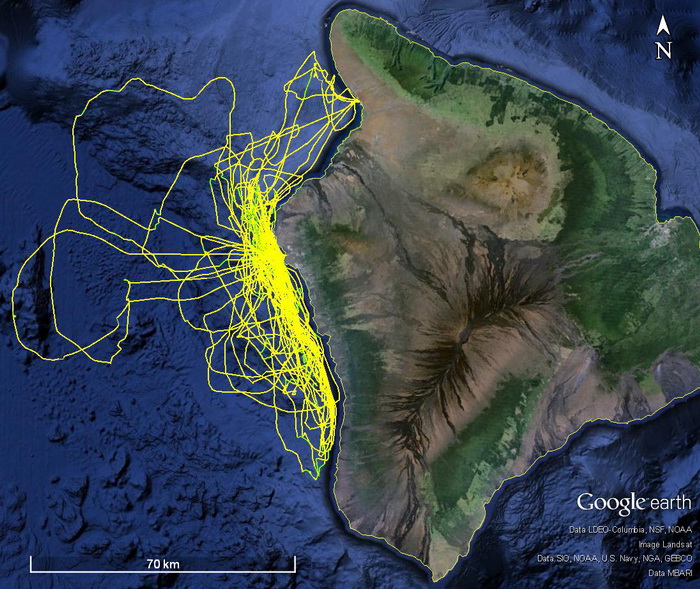
This map shows all our previous effort off the island of Hawai‘i during the month of July – we’ve worked off Kona in July in three different years previously (2006, 2008, 2010).
All photos are copyrighted and should not be used without permission (contact Robin Baird at rwbaird (at) cascadiaresearch.org for permission).
Like us on Facebook page if you want to receive notices of when information is posted and updates on other Cascadia projects.